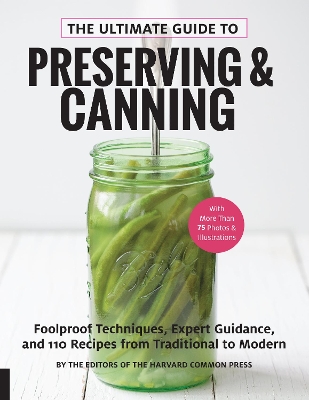Reviewed by annieb123 on
The Ultimate Guide to Preserving and Canning is a recipe and tutorial guide for preserving food using traditional canning techniques. Due out 10th Dec 2019 from Quarto on their Harvard Common Press imprint, it's 224 pages and will be available in paperback format. This book is a distillation/compilation of info from these earlier titles: The Farmer’s Wife Canning & Preserving Cookbook, Lela Nargi, editor (Harvard Common Press 2009); The Fresh Girl’s Guide to Easy Canning and Preserving by Ana Micka (Harvard Common Press 2010); Preserving with Pomona’s Pectin by Allison Carroll Duffy and the Partners at Pomona’s Universal Pectin® (Fair Winds Press 2013); Modern Pressure Canning by Amelia Jeanroy (Harvard Common Press 2018). The material is compiled here for the first time together, though, so readers who are missing the above titles will find a lot of useful material gathered here in one book.
The included tutorials and recipes use both pressure canning and water bath methods for preservation. Most readers will be familiar with both methods. For readers who are beginning or intending to explore pressure canning, this book provides a very good explanation of which to choose, when to use each method, what items are best suited to pressure canning, the items which (for safety reasons) need pressure processing, safety considerations and more. Essential and helpful equipment lists are included and explained very well. The first chapter also explains the choice of food ingredients. When I first started processing our garden produce, my tendency was to process -every- single fruit/vegetable no matter how misshapen, overripe, squishy, or blemished. I hated to 'waste' (compost) -anything- unnecessarily. The authors have a good explanation for why this isn't desirable (you wind up with potentially spoiled food of a much lower quality, potentially wasting the entire batch -talk about serious waste)!
The following chapters include processing and recipes grouped thematically: tomatoes and sauces, veggies, preserves and conserves, jams and jellies, meats, sauces and condiments, stocks broths soups and stews.The recipes are mostly traditional family friendly recipes which would not have been unrecognizable to our great grandmothers. It's nice to have them collected and standardized in one place.
The recipes themselves are easy to read and understand. They include a header bar along with prep/cooking time, yields and a description. Ingredients are listed bullet point in a sidebar. Measurements are given in US standard measures with metric measures in parentheses. Preparation instructions are enumerated step by step. Substitutions and alternative preparation or serving information are given in a footer bar at the end of the recipe.
The book includes a cross referenced index which includes individual ingredients. There is not much photography or illustration included in the book, however those which are included are clear and easy to follow.
I will just say that the included recipe for tom yum gai (Thai chicken coconut soup) is worth the entire price of the book for me and my family. This went straight to the top of the list.
Five stars for all readers who don't already own the above books.
Disclosure: I received an ARC at no cost from the author/publisher for review purposes.
Reading updates
- Started reading
- Finished reading
- 24 November, 2019: Reviewed
